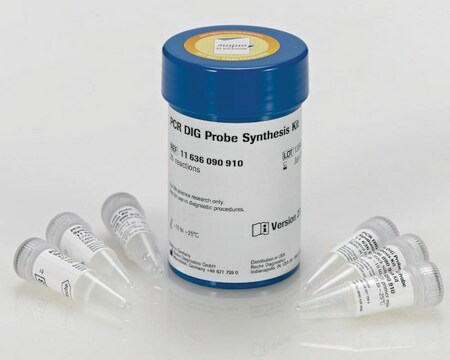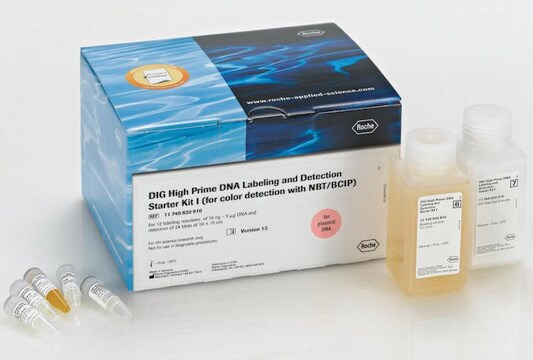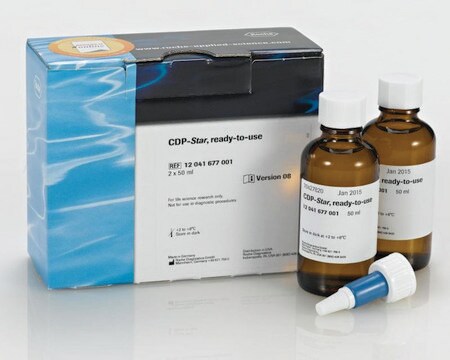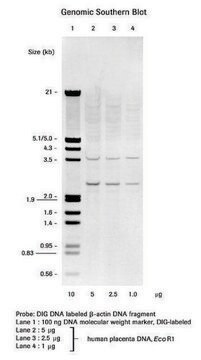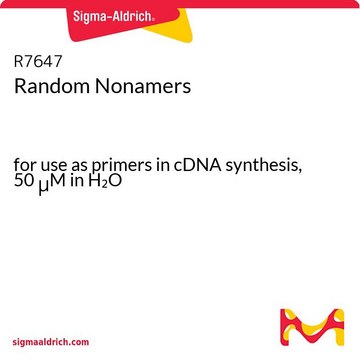11004760001
Roche
Random Primed DNA Labeling Kit
Sinonimo/i:
nucleic acid labeling
Autenticatiper visualizzare i prezzi riservati alla tua organizzazione & contrattuali
About This Item
Codice UNSPSC:
41105500
Prodotti consigliati
impiego
sufficient for 50 labeling reactions
Livello qualitativo
Produttore/marchio commerciale
Roche
Temperatura di conservazione
−20°C
Categorie correlate
Descrizione generale
Random primed DNA labeling kit is used for the radioactive and nonradioactive labeling of DNA with modified deoxyribonucleoside triphosphate using random oligonucleotides as primers. In this method, the complementary DNA strand of denatured DNA is synthesized by Klenow polymerase using the 3′-OH termini of the random oligonucleotides as primers.
Specificità
Heat inactivation: Stop the reaction by adding 2 μl 0.2 M EDTA (pH 8.0) and/or by heating to 65 °C for 10 minutes.
Applicazioni
Random Primed DNA Labeling Kit has been used to label probe or fragments shorter than 1 kb.
Random Primed DNA Labeling Kit is used to uniformly label plasmid or phage DNA with any [α-32P]-dNTP or modified dNTP. Labeled DNA probes with high specific activity are used in a variety of hybridization techniques including:
- Screening of gene libraries
- Southern, dot and northern blots
- In situ hybridizations
Confezionamento
1 kit containing 7 components.
Nota sulla preparazione
Working solution: Preparation dNTP Stock Mix
To avoid pipetting inaccuracy, due to low volumes, prepare a stock mix of unlabeled dNTPs. Aliquots should be stored at -15 to -25 °C. Avoid repeated freezing and thawing.
Preparation of DIG Stock Mix
To avoid pipetting inaccuracy due to low volumes, prepare a DIG stock mix. To do this, mix digoxigenin-11-dUTP [3 mM] and dTTP (vial 5) 1:1. For each labeling reaction 1.6 μl are used.
To avoid pipetting inaccuracy, due to low volumes, prepare a stock mix of unlabeled dNTPs. Aliquots should be stored at -15 to -25 °C. Avoid repeated freezing and thawing.
- dATP, dGTP, dTTP mixture:
For one labeling reaction pipette:
1 μl dATP
1 μl dGTP
1 μl dTTP to a reaction vial
Preparation of DIG Stock Mix
To avoid pipetting inaccuracy due to low volumes, prepare a DIG stock mix. To do this, mix digoxigenin-11-dUTP [3 mM] and dTTP (vial 5) 1:1. For each labeling reaction 1.6 μl are used.
Altre note
For life science research only. Not for use in diagnostic procedures.
Solo come componenti del kit
N° Catalogo
Descrizione
- Control DNA lambda, 20 μl 12.5 µg/ml
- dATP, 50 μl 0.5 mM
- dCTP, 50 μl 0.5 mM
- dGTP, 50 μl 0.5 mM
- dTTP, 50 μl 0.5 mM
- Hexanucleotide mixture in 10x reaction buffer (100 μl)
- Klenow enzyme, labeling grade (100 U)
Codice della classe di stoccaggio
12 - Non Combustible Liquids
Classe di pericolosità dell'acqua (WGK)
WGK 1
Punto d’infiammabilità (°F)
does not flash
Punto d’infiammabilità (°C)
does not flash
Scegli una delle versioni più recenti:
Possiedi già questo prodotto?
I documenti relativi ai prodotti acquistati recentemente sono disponibili nell’Archivio dei documenti.
I clienti hanno visto anche
I J Blader et al.
The Journal of biological chemistry, 276(26), 24223-24231 (2001-04-11)
Cells infected with the intracellular protozoan parasite Toxoplasma gondii undergo up-regulation of pro-inflammatory cytokines, organelle redistribution, and protection from apoptosis. To examine the molecular basis of these and other changes, gene expression profiles of human foreskin fibroblasts infected with Toxoplasma
Fluorescence in situ hybridization to the polytene chromosomes of anopheles mosquitoes
He F, et al.
PLoS Pathogens (2012)
Daniel R Semlow et al.
Cell, 167(2), 498-511 (2016-10-04)
During eukaryotic DNA interstrand cross-link (ICL) repair, cross-links are resolved ("unhooked") by nucleolytic incisions surrounding the lesion. In vertebrates, ICL repair is triggered when replication forks collide with the lesion, leading to FANCI-FANCD2-dependent unhooking and formation of a double-strand break
Margit Dlaska et al.
Cell cycle (Georgetown, Tex.), 12(13), 2084-2099 (2013-06-14)
Immortal cells require a mechanism of telomere length control in order to divide infinitely. One mechanism is telomerase, an enzyme that compensates the loss of telomeric DNA. The second mechanism is the alternative lengthening of telomeres (ALT) pathway. In ALT
Masayuki Kimura et al.
Nature protocols, 5(9), 1596-1607 (2010-11-19)
In this protocol we describe a method to obtain telomere length parameters using Southern blots of terminal restriction fragments (TRFs). We use this approach primarily for epidemiological studies that examine leukocyte telomere length. However, the method can be adapted for
Protocolli
Random Primed DNA Labeling Kit Protocol & Troubleshooting
Il team dei nostri ricercatori vanta grande esperienza in tutte le aree della ricerca quali Life Science, scienza dei materiali, sintesi chimica, cromatografia, discipline analitiche, ecc..
Contatta l'Assistenza Tecnica.
